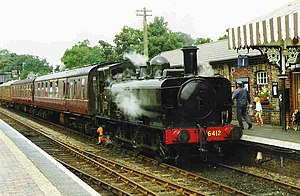GWR 6400 Class

6400 Class No. 6412 arrives at Sheringham, North Norfolk Railway, August 1999
|
|||||||||||||||||||||||||||||
|
|||||||||||||||||||||||||||||
|
|||||||||||||||||||||||||||||
|
|||||||||||||||||||||||||||||
|
|||||||||||||||||||||||||||||
| Type and origin | |
|---|---|
| Power type | Steam |
| Designer | Collett |
| Builder | GWR 6400 and 30 7400; BR 20 7400 |
| Build date |
|
| Total produced |
|
| Specifications | |
|---|---|
| Configuration | 0-6-0PT |
| Gauge | 4 ft 8 1⁄2 in (1,435 mm) standard gauge |
| Driver dia. | 4 ft 7 1⁄2 in (1.410 m) |
| Loco weight |
|
| Fuel type | Coal |
| Fuel capacity | 3 long tons 18 cwt (8,700 lb or 4 t) (3.2 short tons) |
| Water cap | 1,100 imp gal (5,000 l; 1,300 US gal) |
| Firebox: • Firegrate area |
16.76 sq ft (1.557 m2) |
| Boiler pressure |
|
| Cylinders | two inside |
| Cylinder size | 16 1⁄2 in × 24 in (419 mm × 610 mm) |
| Valve gear | Stephenson |
| Valve type | piston valves |
| Performance figures | |
|---|---|
| Tractive effort |
|
| Career | |
|---|---|
| Power class |
|
The Great Western Railway (GWR) 6400 Class is a class of 0-6-0 pannier tank steam locomotive introduced by Charles Collett in 1932. All 40 examples were 'auto-fitted' – equipped with the remote-control equipment needed for working autotrains.
The 1936 GWR 7400 Class was a similar class, without the autotrain apparatus, but with a higher boiler pressure of 180 psi, providing a small but useful increase in power. An initial build of 30 in 1936-1937 was added to by British Railways in two batches each of ten locos in 1948 and 1950. These were destined for a short life, the briefest being only nine years. A minor visual difference between the 64xx and 74xx classes was at the join between cab and bunker. The 64xx had an arc whereas the later class was straight.
Both classes were closely related to the 1930 GWR 5400 Class, which was in turn an evolution of both the Armstrong 1874 GWR 850 Class and the Dean 1891 GWR 2021 Class. Thus the basic design was almost sixty years old when new, the 4 ft 7 1⁄2 in (1.410 m) driving wheels being the main distinguishing factor, apart from the more modern profile. There were also superficial similarities with the GWR 645 Class as extant in the 1930s, that also had 4 ft 7 1⁄2 in (1.410 m) wheels and 24 in (610 mm) stroke cylinders (and by then pannier tanks and full cabs).
The smaller wheels of the 64xx's permitted operation in hillier locations than the 5400 Class and allocations were initially to the South Wales valleys.
...
Wikipedia
